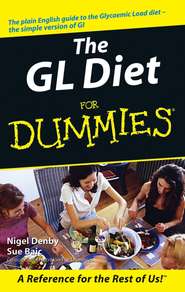По всем вопросам обращайтесь на: info@litportal.ru
(©) 2003-2024.
✖
The GL Diet Cookbook: Over 150 tasty recipes for easy weight loss
Настройки чтения
Размер шрифта
Высота строк
Поля
History: Avocado seeds were found buried with a mummy dating back to the 8th century BC.
Health bite: Use extra-virgin, cold-pressed. Contains vitamin E and Omega 9.
Everyday uses: Salads or use instead of butter with mashed vegetables.
Coconut oil
History: Coconut oils were recognized as ‘health oils’ in Ayurvedic medicine as far back as 4,000 years ago.
Health bite: Look for virgin coconut oil. Rich in lauric acid, antiviral, antibacterial and antifungal. A saturated fat, so less likely to be damaged when heated.
Everyday uses: Cooking at high temperatures. Very long shelf-life at room temperature.
Flaxseed oil (or linseed oil)
History: Flaxseed is an ancient grain. Hippocrates wrote of using flax for relief of stomach pains in 650BC.
Health bite: Rich source of Omega 3 and excellent source of protein, potassium and beta carotene. May help constipation and IBS.
Everyday uses: Delicate nutty flavour, add lemon juice or vinegar for dressings. Keep refrigerated. Short shelf-life. Not suitable for cooking.
Groundnut oil (peanut oil)
History: The peanut originated in Brazil. In 1890 in America it was promoted as a replacement for the cotton crop destroyed by the boll weevil.
Health bite: Contains high levels of plant sterols which research shows may protect against colon, breast and prostate cancer.
Everyday uses: Cooking – especially stir-fries. Has a neutral taste and high burn point.
Hazelnut oil
History: The word hazel comes from the anglo saxon word haesel meaning ‘bonnet’, referring to the shape of the outer shell. Hazelnuts have been cultivated in China for the last 5,000 years.
Health bite: Rich in Vitamin E.
Everyday uses: Nutty, rich and flavourful. A little goes a long way. Use in salad dressings with a bit of olive oil, goes well with asparagus. Can be used in baked goods.
Olive oil
History: The olive dates back to 17th century BC and was mentioned in Egyptian records and several times in the Bible. It has been a sign of peace and truce for millennia.
Health bite: Heart healthy. Doesn’t need high temperature or chemical processing, since it is made from the flesh of the olive and not the seed. Look for extra-virgin olive oil as it comes from the first pressing of the olives and is therefore the highest quality.
Everyday uses: Any salad dressings; try mixing with balsamic or red wine vinegar. You can cook with extra-virgin although it is more expensive. Fine for medium-temperature cooking but don’t overheat. Good shelf-life.
Pumpkin seed oil
History: First recorded reference in Austria 1739. Gourmets have appreciated the culinary and health properties of this delicacy for centuries.
Health bite: Healthy monounsaturated fat, helps increase HDL (good cholesterol) and high in zinc.
Everyday uses: Adding flavour to soups, salad dressings. Try mixing with olive oil, mustard and apple vinegar.
Rice bran oil
History: A newcomer on the block. Production first started in the US in 1960s.
Health bite: A good healthy alternative oil. Great source of vitamin E, antioxidants and micronutrients. Studies in 1990s have demonstrated it helps reduce cholesterol levels.
Everyday uses: Salads. Also has a very high smoke point, so ideal for pan- and stir-frying. Foods cooked in rice bran oil absorb less oil during cooking. Excellent shelf-life.
Sesame oil
History: Babylonians used it for making exotic perfumes, cooking, sesame cakes and as a medicine. A purchase of sesame oil was recorded on an Egyptian clay tablet in King Nebuchadnezzar’s palace records in 6th century BC.
Health bite: High in vitamin E. Dark in colour with strong, distinctive flavour.
Everyday uses: Add small amount to stir-fries at end of cooking time, use in salad dressings, or drizzle over steak. Not suitable for cooking. Long shelf-life.
Walnut oil
History: Around 2,000BC, clay tablets in Mesopotamia revealed the existence of walnut groves within the Hanging Gardens of Babylon. Produced in France, where it is well loved and used widely.
Health bite: Very high in Omega 3.
Everyday uses: Salad dressings: combine it with olive oil. Goes well with fruit, cheese and walnuts, often used with fish. Not suitable for cooking. Short shelf-life.
Flavoured/Infused Olive Oils
Chilli olive oil – great with mozzarella cheese, tomato sauces or chocolate
Garlic olive oil – good for sauces, pasta, vegetables, fish or meat
Basil olive oil – goes well with rice and pasta salads, soups and tomato sauces
Rosemary olive oil – use with potatoes, fish, beans, risotto or chocolate
Lemon olive oil – ideal for mayonnaise or with white or red meat or tomatoes
Ginger olive oil – good for soups, fish, meat, rice and cakes
Porcini mushroom olive oil – use in risottos, sauces, soups and with vegetables
Chapter 4 GROOVY GRAINS AND FRIENDLY FLOURS (#ulink_7a752857-117d-59c0-b1e2-14c9a2f827b7)
What Are Wholegrains?
When grains are milled or refined, the bran (the fibre-rich outer layer of the kernel) and germ (the nutrient-rich inner part) are removed, leaving only the endosperm (the middle starchy bit). Most of the nutritional value of the grain is lost in the process, because the bran and the germ contain the highest concentration of nutrients.









